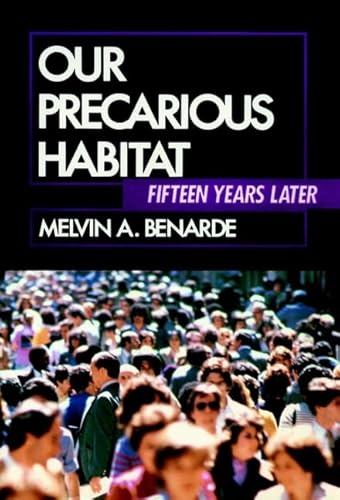Items related to Our Precarious Habitat: Fifteen Years Later

If you think the world is a time bomb ready to explode, consider this: Cancer deaths are going down, not up. The infant mortality rate is at an all-time low, while our population over 60 is at an all-time high. The 1988 U.S. summer drought was caused by tropical disturbances in the Pacific Ocean and, contrary to the popular media, had little to do with the "greenhouse effect." Here’s the book that explodes the many myths about... Our Precarious Habitat Fifteen Years Later Earth Day 1970. "Apocalyptics" such as eminent physiologist and Nobel Laureate George Wald were predicting large-scale environmental doom by the year 2000, and a movement was under way that would influence our thoughts and opinions about the health of the planet to this day. Today, nearly twenty years later, those predictions appear well off the mark. In this book, Dr. Melvin Benarde, one of today’s leading environmental experts, challenges the remaining environmental myths of our time. He comes armed with a healthy skepticism of the "facts," plus scientifically documented evidence indicating, in many cases, that "our precarious habitat" is not as precarious as the doomsayers would have us believe. Questioning current environmental myths is an idea whose time has come. By initiating the inquest, Our Precarious Habitat stands at the forefront of a new environmental era, an era whose watchword is accountability. This book benefits all of us—concerned citizens, elected officials, members of industry, and the media alike—who want a clearer perspective on the issues that will determine our environmental fate.
"synopsis" may belong to another edition of this title.
From the Publisher:
Assesses recent scientific findings concerning the impact of environmental risk factors on human health. Emphasizes the need to adequately research current statements on the status of the environment. Clarifies the economic, social, political, and pyschological ramifications inherent in current environmental issues. Topical subjects covered include chemicals in food, pesticides, forms of pollution, sewage treatment problems, health issues, and the politics of pollution.
From the Inside Flap:
Just three months after the "Greenhouse Summer of 1988," Andrew Solow, a statistics expert at the Woods Hole Oceanographic Institute, wrote in The New York Times that "existing data shows no evidence of the greenhouse effect. Many people will be surprised to hear that this is more or less the view expressed in scientific journals, where articles are subject to peer review. Congressional testimony and interviews in the press are not subject to peer review, and that is how unsubstantiated and misleading statements come to dominate public opinion." One week later, The New York Times reported that, "according to new scientific evidence, the 1988 summer drought in the United States was caused by massive, naturally occurring climatic forces in the tropical Pacific Ocean and had little to do with global warming caused by the greenhouse effect." These two reports exemplify the powerful message this book contains. Written 15 years after publication of the original work and approximately 15 years after the height of the environmental "panic" of the 1970s, Our Precarious Habitat: Fifteen Years Later thoughtfully reexamines the environmental issues and problems that emerged in the 1970s—issues and problems that are still very much with us today. From this calmer perspective, environmental expert Melvin Benarde provides surprising, scientifically documented evidence indicating that, in many cases, "our precarious habitat" is not just liveable but is, in fact, a remarkably healthy place. Throughout, Dr. Benarde dispels environmental myth after myth as he measures today’s most sensitive barometers of environmental health—cancer death rates; birth and infant mortality rates; air, water, and noise pollution; hazardous wastes; chemicals in food; pesticides; accidents and occupational health; sanitary sewage and waste water treatment; disease patterns; and more. All facts, figures, tables, and charts are derived from leading authoritative sources in the scientific community and presented in easy-to-understand layman’s terms. Most importantly, Benarde gives us practical risk assessment tools and techniques to help us deal with the economic, social, political, and psychological ramifications inherent in all environmental issues. We learn the ropes of the "politics of pollution," and how to "overcome our typically passive acceptance of the daily fare that is served up to us," and replace it with a healthy skepticism toward what really is and isn’t a threat to the quality of human life. With this new mindset, we can begin to ask, "Wait a minute, what’s the evidence for that?" or say "Run that by me again." Our Precarious Habitat is a rallying point for these kinds of questions, a source for everyone—citizens, elected officials, members of industry, and the media—to turn to for information and guidance on how to become more accountable and informed about the shared environment in which we live.
"About this title" may belong to another edition of this title.
- PublisherWiley
- Publication date1989
- ISBN 10 0471617504
- ISBN 13 9780471617501
- BindingHardcover
- Edition number1
- Number of pages656
Buy New
Learn more about this copy
US$ 96.97
Shipping:
US$ 5.91
Within U.S.A.
Top Search Results from the AbeBooks Marketplace
OUR PRECARIOUS HABITAT: FIFTEEN
Seller:
Rating
Book Description Condition: New. New. In shrink wrap. Looks like an interesting title! 2.41. Seller Inventory # Q-0471617504
Buy New
US$ 96.97
Convert currency

